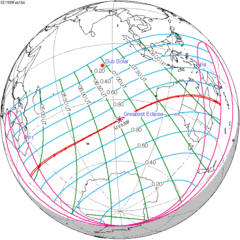| Total Lunar Eclipse February 9, 1990 | |
|---|---|
| (No photo) | |
 The moon passes west to east (right to left) across the Earth's umbral shadow, shown in hourly intervals. | |
| Series | 133 (25 of 71) |
| Gamma | -0.4148 |
| Magnitude | 1.0750 |
| Duration (hr:mn:sc) | |
| Totality | 42:18 |
| Partial | 3:24:18 |
| Penumbral | 5:39:36 |
| Contacts (UTC) | |
| P1 | 16:22:14 |
| U1 | 17:29:53 |
| U2 | 18:50:53 |
| Greatest | 19:12:02 |
| U3 | 19:33:11 |
| U4 | 20:54:11 |
| P4 | 22:01:50 |
A total lunar eclipse took place on Friday, February 9, 1990, the first of two lunar eclipses in 1990.[1]
YouTube Encyclopedic
-
1/2Views:54315 262
-
Solar eclipse in 90 seconds
-
The Elders ~ October 2014 ~ Blood Full Moon Lunar Eclipse and the Embrace of the Ego Self
Transcription
Visibility
It was visible from all of Africa, Europe, Asia and Australia. The eclipse is sighted over the Philippines since the one that happened on February 20, 1989.
Related eclipses
Eclipses of 1990
- An annular solar eclipse on January 26.
- A total lunar eclipse on February 9.
- A total solar eclipse on July 22.
- A partial lunar eclipse on August 6.
Lunar year series
| Lunar eclipse series sets from 1988–1991 | ||||||||
|---|---|---|---|---|---|---|---|---|
| Descending node | Ascending node | |||||||
| Saros | Date | Type Viewing |
Gamma | Saros | Date Viewing |
Type Chart |
Gamma | |
| 113 | 1988 Mar 03
|
Penumbral
|
0.98855 | 118 | 1988 Aug 27
|
Partial
|
−0.86816 | |
| 123 | 1989 Feb 20
|
Total 
|
0.29347 | 128 | 1989 Aug 17
|
Total
|
−0.14905 | |
| 133 | 1990 Feb 09
|
Total
|
−0.41481 | 138 | 1990 Aug 06
|
Partial
|
0.63741 | |
| 143 | 1991 Jan 30
|
Penumbral
|
−1.07522 | 148 | 1991 Jul 26
|
Penumbral
|
1.43698 | |
| Last set | 1987 Apr 14 | Last set | 1987 Oct 07 | |||||
| Next set | 1991 Dec 21 | Next set | 1991 Jun 27 | |||||
Lunar Saros 133
This lunar eclipse is part of series 133 of the Saros cycle, which repeats every 18 years and 11 days. Series 133 runs from the year 1557 until 2819. The previous eclipse of this series occurred on January 30, 1972 and the next will occur on February 21, 2008.
It is the 5th of 21 total lunar eclipses in series 133. The first was on December 28, 1917. The last (21st) will be on August 3, 2278. The longest two occurrences of this series (14th and 15th) will last for a total of 1 hour and 42 minutes on May 18, 2152 and May 30, 2170. Solar saros 140 interleaves with this lunar saros with an event occurring every 9 years 5 days alternating between each saros series.
Tritos series
- Preceded: Lunar eclipse of March 13, 1979
- Followed: Lunar eclipse of January 9, 2001
Tzolkinex
- Preceded: Lunar eclipse of December 30, 1982
- Followed: Lunar eclipse of March 24, 1997
Half-Saros cycle
A lunar eclipse will be preceded and followed by solar eclipses by 9 years and 5.5 days (a half saros).[2] This lunar eclipse is related to two annular solar eclipses of Solar Saros 140.
| February 4, 1981 | February 16, 1999 |
|---|---|

|

|
See also
Notes
- ^ Hermit Eclipse: Saros cycle 133
- ^ Mathematical Astronomy Morsels, Jean Meeus, p.110, Chapter 18, The half-saros
External links
- 1990 Feb 09 chart Eclipse Predictions by Fred Espenak, NASA/GSFC




